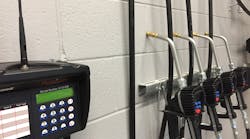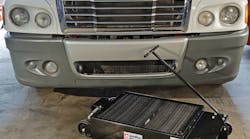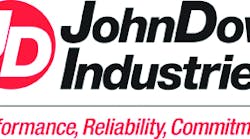If fleets want a truly efficient lubrication system for the shop, they must view it in a more holistic way. “Fleets must look at efficiency, contamination control and consumption all at the same time,” says Mark Jones, lubrication reliability consultant for Lubrication Engineers, a manufacturer of high-performance lubricants and lubrication reliability products.
“A fleet also needs to think about its budget,” Jones adds. "If you went all out on every aspect, you could easily spend $80,000 to $100,000. If you can't spend that kind of money, there are plenty of options to help you configure a productive and reliable system.”
Configuration considerations
How a fleet goes about configuring a lubrication system will depend on its unique circumstances. Jones always asks a fleet: How do you take your oil to work?
“You have to look at your own situation to determine what is best in terms of equipment and placement," Jones says.
Fleets that need to turn vehicles as quickly as possible can benefit greatly from a system where hoses drop from the ceiling. That eliminates the need for technicians to walk around refilling their dispensing containers.
“I look to see where vehicles pull in to determine where hoses need to drop from,” says Jimmy Kukulski, president of Elite Lubrication Specialties. “It’s all about making it as easy as possible for the fleet without affecting oil quality and cleanliness. I also try to make it easier for whomever is delivering oil." Kukulski is also a manufacturer's rep for Lubrication Engineers.
There are alternatives to ceiling-dropped hoses, Jones reminds.
"Some shops don't have the right facility setup or budget to run hoses," he says. "Color-coded top-off containers are a good solution. They have unique lids and spouts that make dispensing easier."
Cart-mounted mobile transfer tanks represent another alternative. They allow technicians to keep a lube supply closer by, reducing the downtime associated with having to walk to the main storage container to refill dispensing containers.
When configuring a shop's lubrication system, fleets should keep an eye on the future.
“Many changes in lubricants have happened over the past 10 years as OEMs try to increase fuel economy,” says Don Youman, president and COO of Balcrank, a manufacturer of fluid dispensing equipment used in the automotive, commercial and industrial markets. “That has resulted in high-tech, advanced low- and multi-viscosity oils. Planning for the future will make the management of these fluids less costly over the long-run.”
Youman says fleets must have a good understanding of the following:
- Number and grade of fluids the shop will be consuming
- Phase-in and phase-out of lubricants
- Tank capacities and future permitting/requirements
- Design and footprint of tanks
- Adequate tank room size
- Venting, piping and alerts/alarms that indicate low- or high-level fluid status
Storage, pumping and dispensing
With respect to fluid storage, container size should be dictated by a fleet's rate of consumption. Elite Lubrication Specialties’ Kukulski says fleets can do themselves a favor.
"Look at your PMs [preventive maintenance schedules] and the quality of the oil you are using," Kukulski says. "A lot of fleets will drain at 10,000 miles, but they likely could go a lot further if using a premium lubricant with extended drain intervals. Getting your drain intervals dialed in could allow you to go with a 500-gal bulk tank as opposed to a 1,500-gal tank. That smaller tank will consume less space and overhead, and running lean is pretty important these days."
Fleets also need to think about tank construction. "You could go with steel storage tanks that hold several-hundred gallons," Lubrication Engineers’ Jones says. "Fleets may also have the option of poly (plastic) that you can see through to monitor levels. Check with your insurance company to ensure that poly is even an option for you." If poly is an option, totes are becoming increasingly popular. They are smaller and stackable so they consume a smaller footprint in the shop.
Once fleets have devised a bulk storage plan, it's time to scrutinize the pumping system. As Balcrank's Youman points out, flow rate is a critically important consideration.
“Proper flow rate is a function of how long the actual dispense takes,” Youman explains. “In an automotive shop, we want to see a minimum 1-gpm [gallons per minute] flow rate. An average car takes 5 quarts of oil, so you could fill the crankcase in just over a minute. But when you have a large vehicle that may take 30 to 50 gallons, flow rates need to be more like 5 to 8 gpm.”
Something else to consider is the number of simultaneous dispense points for each fluid.
“Overall flow requirements equate to pump selection and sizing,” Youman says. “Also, pumping distance per fluid tells us the required pipe/tubing requirement to achieve the flow and pressure needed to achieve the desired fill time. Then, pump sizing not only determines system performance, but also long-term reliability and dependability of the system.”
The underlying objective is to install an efficient, clutter-free way to dispense fluids and manage dispense points. Youman says fleets should consider the following:
- Hose reel design suited for the demands of the shop
- Hose reel mounting and location to ensure optimum efficiencies
- Hose size matched to flow rate requirements
- Control handle flow rates and features
“Hose and piping cause restrictions – and the smaller the diameter, the greater the restriction,” Youman says. “We use a pressure drop calculator that uses fluid viscosity and required flow rates. Then we can dial in the appropriate pipe and hose sizing to achieve the flow rates required. It is always best to get us involved in applications where the required flow rates are high and pumping distances are very long. In these applications, pipe diameter can be critical to the system functioning properly.”
Maintaining lubricant quality
An often forgotten consideration when devising a lubrication system plan is maintaining product quality. Lubrication Engineers’ Jones says it requires vigilance from cradle to grave.
It's a good idea to sample a fluid at the time of delivery.
"Then you know exactly what you're getting," Jones says.
It is possible that the wrong fluid grade could be delivered, which could lead to cross-contamination.
"Fleets need to maintain control of their fluid supply," Jones continues. "This is important because you're moving a fluid from the delivery truck to the bulk storage container to the dispensing device. The fluid is naturally going to get dirtier along the way. This is why I also recommend an oil analysis every few months."
Elite Lubrication Specialties' data shows that 50 to 70 percent of lubricant contamination comes from outside of the equipment. Kukulski says that whenever he walks into a shop, one of the first things he does is wipe the floor with his finger to show the fleet manager how much dirt is present.
"The vent going into the storage tank is breathing that same air," Kukulski says.
Desiccant breathers on storage tanks can stop particulates – as well as moisture – from contaminating your fluid supply.
"Too many fleets leave their storage tanks wide open to the atmosphere," Kukulski says. "They burn through pumps, motors and engines and don't understand why. Breathers are very important, especially if you're operating in an especially dusty and/or humid environment."
Desiccant breathers are designed to be easy to install. They replace the standard dust cap or OEM breather cap on top of a storage container.
Kukulski reminds fleets to also guard against what could be happening inside of the storage tank. Engine oils have a lot of Moly (Molybdenum Disulfide) in them. Moly tends to settle out, especially if the oil has been sitting for a long time. Soon there's a sludge in the bottom of the tank.
"That's why inline filtering is so important," Kukulski says.
Preventing cross-contamination
The typical fleet could have upwards of 10 different types of fluids in its shop: different grades of engine oil, hydraulic oil and gear oil, as well as DEF fluid and coolant, etc. The more fluids a fleet has, the more susceptible it is to cross-contamination.
Fleets should identify every vehicle and what fluids they need, and write it all down. This is especially important when operating a diverse fleet. For vehicles still under warranty, stick with the OEM-recommended fluids. When out of warranty, fleets can look for the opportunity to consolidate, perhaps moving up to a more premium grade of fluid that can be used across numerous vehicles within the fleet.
Whatever a fleet does, technicians have to keep it all straight.
"Mixing engine oils is bad enough," Lubrication Engineers’ Jones says. "But if you get some coolant mixed with an oil, you might as well call a tow truck right now. The same is true with hydraulic oils. There are different additives for different oils. Using the wrong one could contaminate the system and cause a pump or servo to go out."
This is why Jones is such a believer in color-coding. Lubrication Engineers has identified nine common oils and seven greases. Each is given its own color with respect to storage tanks and dispensers. For example, blue with a star would be on the storage tank, dispensing container, mobile tank and/or hose reel for that lubricant.
"Training is very important," Jones says. "Make sure all of your technicians understand what contamination can do and why this color-coding is so important."
Consumption and profitability
Since efficiency and profitability is the ultimate goal, it’s important for fleets to ensure that every drop of oil is accounted for.
“We see oil shrinkage rates of up to 10 percent,” Balcrank's Youman says of both the automotive and heavy duty trucking industries. “This is a staggering loss of revenue, but can be recouped by installing the proper FIC (fluid inventory control) system, which will pinpoint shrinkage issues, help reconcile deliveries, and ensure that every dispensed drop is billed accurately to a specific work order.”
Today’s comprehensive FIC systems can track a variety of essential fleet management data, Youman points out, as well as assist with overall sound management. For example:
- Bulk oil inventory: how many gallons of each grade are in the tanks
- Dispense tracking: which technician, when, number of quarts, which grade, dispense location
- Used fluids: overfill prevention and proper tank capacity
- Billing: inventory reconciliation, inventory shrinkage prevention
"Measured meters on hose reels allow technicians to set the desired amount of oil and then dispense that amount without fear of overfilling," Lubrication Engineers' Jones adds.
It's all about reducing the opportunity for human error and making things easier on the technicians. When fleets strike that perfect balance between efficiency and quality, they can achieve maximum ROI on their lubrication storage and dispensing systems.





